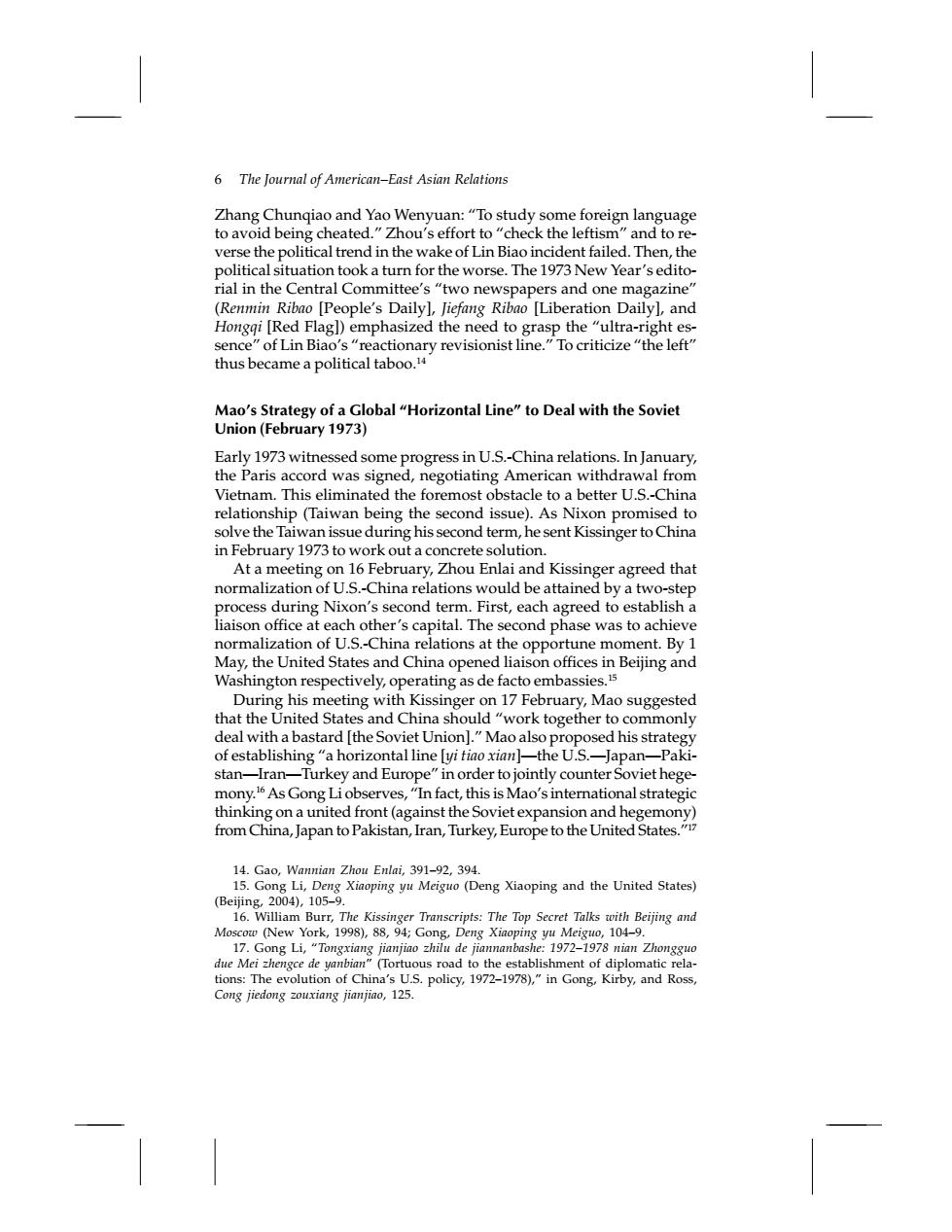正在加载图片...

6 The Journal of American-East Asian Relations Zhang Chungiao and Yao Wenyuan:"To study some foreign language to avoid being cheated."Zhou's effort to "check the leftism"and to re- verse the political trend in the wake of Lin Biao incident failed.Then,the political situation took a turn for the worse.The 1973 New Year's edito- rial in the Central Committee's"two newspapers and one magazine" (Renmin Ribao [People's Daily],Jiefang Ribao [Liberation Daily],and Hongqi [Red Flag])emphasized the need to grasp the"ultra-right es- sence"of Lin Biao's"reactionary revisionist line."To criticize"the left" thus became a political taboo.4 Mao's Strategy of a Global "Horizontal Line"to Deal with the Soviet Union(February 1973) Early 1973 witnessed some progress in U.S.-China relations.In January, the Paris accord was signed,negotiating American withdrawal from Vietnam.This eliminated the foremost obstacle to a better U.S.-China relationship (Taiwan being the second issue).As Nixon promised to solve the Taiwan issue during his second term,he sent Kissinger to China in February 1973 to work out a concrete solution. At a meeting on 16 February,Zhou Enlai and Kissinger agreed that normalization of U.S.-China relations would be attained by a two-step process during Nixon's second term.First,each agreed to establish a liaison office at each other's capital.The second phase was to achieve normalization of U.S.-China relations at the opportune moment.By 1 May,the United States and China opened liaison offices in Beijing and Washington respectively,operating as de facto embassies.15 During his meeting with Kissinger on 17 February,Mao suggested that the United States and China should"work together to commonly deal with a bastard [the Soviet Union]."Mao also proposed his strategy of establishing"a horizontal line [yi tiao xian]-the U.S.-Japan-Paki- stan-Iran-Turkey and Europe"in order to jointly counter Soviet hege- mony.16 As Gong Li observes,"In fact,this is Mao's international strategic thinking on a united front(against the Soviet expansion and hegemony) from China,Japan to Pakistan,Iran,Turkey,Europe to the United States."7 14.Gao,Wannian Zhou Enlai,391-92,394. 15.Gong Li,Deng Xiaoping yu Meiguo (Deng Xiaoping and the United States) (Beijing,2004),105-9. 16.William Burr,The Kissinger Transcripts:The Top Secret Talks with Beijing and Moscow (New York,1998),88,94;Gong,Deng Xiaoping yu Meiguo,104-9. 17.Gong Li,"Tongxiang jianjiao zhilu de jiannanbashe:1972-1978 nian Zhongguo due Mei zhengce de yanbian"(Tortuous road to the establishment of diplomatic rela- tions:The evolution of China's U.S.policy,1972-1978),"in Gong,Kirby,and Ross, Cong jiedong zouxiang jianjiao,125.6 The Journal of American–East Asian Relations Zhang Chunqiao and Yao Wenyuan: “To study some foreign language to avoid being cheated.” Zhou’s effort to “check the leftism” and to reverse the political trend in the wake of Lin Biao incident failed. Then, the political situation took a turn for the worse. The 1973 New Year’s editorial in the Central Committee’s “two newspapers and one magazine” (Renmin Ribao [People’s Daily], Jiefang Ribao [Liberation Daily], and Hongqi [Red Flag]) emphasized the need to grasp the “ultra-right essence” of Lin Biao’s “reactionary revisionist line.” To criticize “the left” thus became a political taboo.14 Mao’s Strategy of a Global “Horizontal Line” to Deal with the Soviet Union (February 1973) Early 1973 witnessed some progress in U.S.-China relations. In January, the Paris accord was signed, negotiating American withdrawal from Vietnam. This eliminated the foremost obstacle to a better U.S.-China relationship (Taiwan being the second issue). As Nixon promised to solve the Taiwan issue during his second term, he sent Kissinger to China in February 1973 to work out a concrete solution. At a meeting on 16 February, Zhou Enlai and Kissinger agreed that normalization of U.S.-China relations would be attained by a two-step process during Nixon’s second term. First, each agreed to establish a liaison office at each other’s capital. The second phase was to achieve normalization of U.S.-China relations at the opportune moment. By 1 May, the United States and China opened liaison offices in Beijing and Washington respectively, operating as de facto embassies.15 During his meeting with Kissinger on 17 February, Mao suggested that the United States and China should “work together to commonly deal with a bastard [the Soviet Union].” Mao also proposed his strategy of establishing “a horizontal line [yi tiao xian]—the U.S.—Japan—Pakistan—Iran—Turkey and Europe” in order to jointly counter Soviet hegemony. 16As Gong Li observes, “In fact, this is Mao’s international strategic thinking on a united front (against the Soviet expansion and hegemony) from China, Japan to Pakistan, Iran, Turkey, Europe to the United States.”17 14. Gao, Wannian Zhou Enlai, 391–92, 394. 15. Gong Li, Deng Xiaoping yu Meiguo (Deng Xiaoping and the United States) (Beijing, 2004), 105–9. 16. William Burr, The Kissinger Transcripts: The Top Secret Talks with Beijing and Moscow (New York, 1998), 88, 94; Gong, Deng Xiaoping yu Meiguo, 104–9. 17. Gong Li, “Tongxiang jianjiao zhilu de jiannanbashe: 1972–1978 nian Zhongguo due Mei zhengce de yanbian” (Tortuous road to the establishment of diplomatic relations: The evolution of China’s U.S. policy, 1972–1978),” in Gong, Kirby, and Ross, Cong jiedong zouxiang jianjiao, 125